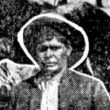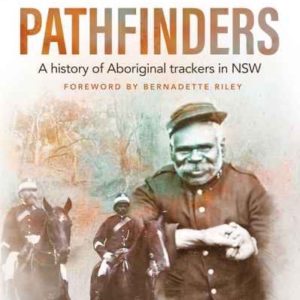Loading map...

Mount Boppy probably has the record for the shortest tenure of a tracker in NSW. A small gold-mining settlement 50 kilometres east of Cobar in Ngiyampaa country, a tracker was based at Mount Boppy for only the month of January 1904. Known only as Jack, he had previously served as the tracker at Cobar and then moved on to Mount...
Learn More ►The Police Station at Mount McDonald near Cowra was staffed by trackers from 1883 to 1886 and probably earlier. Part of the Milburn Creek Gold Field, trackers played an important role in guarding the gold escort, a coach which traveled to Carcoar and sometimes Blayney carrying the miner's finds. The tracker accompanied the escort and stayed overnight before returning to...
Learn More ►Joseph Murray, son of George Murray of Gundabooka, was born at Bourke in about 1890. A talented horseman who stood over six feet tall, he was recruited by the police to work at the Redfern police stables soon after the end of WWI. The police relied on Murray to break in many of their new horses. Murray treated horses...
Learn More ►Eric “Nugget” Mumbler was born at Kempsey in about 1916 to Harold Mumbler from the NSW south coast and Jane Drew of Pelican Island on the lower reaches of the Macleay River. Eric was living at Kempsey in September 1937 when he married Helen Donovan who also had ties to the south coast and Nambucca Heads. The couple raised a...
Learn More ►Peter Wandy was born in Western Australia in the early 1880s, possibly in the Kalgoorlie-Coolgardie district, which is approximately 550km east-north-east of Perth. As a young man he was the tracker at Kalgoorlie for four years before picking up work on a cattle station. Peter quickly left after suffering physical abuse at the hands of the boss. He moved to...
Learn More ►Broughton (also known as Toodwick, an anglicized version of his Aboriginal name) was an Aboriginal man from the lower Shoalhaven River in the vicinity of Coolangatta Mountain, or Cullunghutti as it was originally recorded. Born in the late 18th century, he worked as a young man for Charles Throsby of Liverpool and later as a...
Learn More ►The first police station at Milparinka was established in 1881, not long after the discovery of gold at Mount Poole and the subsequent opening of the Albert Goldfield. Thousands of miners flocked to the area and six policemen were posted at Milparinka to help control them. The stone police station shown in the accompanying photograph was constructed in 1885. Trackers...
Learn More ►Trackers were employed at Byrock Police Station from 1884 to at least 1938. The career of the first Byrock tracker, Jack Todhunter, was tragically short. He contracted typhoid fever two months after starting the job. He was transferred to Dubbo Hospital when his condition deteriorated and he passed away there on 10 March 1885. Little is known about Todhunter. He...
Learn More ►Fred Briggs, a Gumbaynggirr man, was born at Farquarhar’s Creek near Nymboida in about 1866 to Thomas Briggs and Mary. His tracking prowess came to prominence when he found Edward Blaxland, his employer, in mountainous country on Marengo Station in the mid-1880s. Briggs was working as a stockman at the time. His first official employment as tracker was at Blicks...
Learn More ►Tommy Ryan, a noted Aboriginal stockman on the Upper Clarence between Grafton and Yulgilbar, was born in about 1860. It is likely that he was a Bundjalung speaker. He never worked as a tracker , but his run-ins with police meant that several trackers were sent after him. His story is significant because of his ability to repeatedly escape custody....
Learn More ►Billy Nicholls was born at Tabulam in about 1869, possibly to Billy Nicholls Senior who was a gold miner in the Tabulam district and an Aboriginal woman named Ellen Walker. Billy started as the tracker at Copmanhurst on the Clarence River in September 1908 replacing Carty Cregg. Previously, Billy had worked as a stockman for George Barnier at Moleville (12km...
Learn More ►This article is reproduced with the kind permission of the team at Koori History. See the original article written by John T. Patten at https://koorihistory.com/tracker-patten/ John James Patten, known as Jack Patten, was born in the Snowy Mountains of Victoria at Corryong in 1874. He was the eldest son of John Patten, a man for whom there is...
Learn More ►Working at Mount McDonald from June 1882 until the end of 1884, Tommy Pearce’s career is unusual in that it provides evidence that trackers sometime took a holiday. On Friday 27 April 1883, he passed through Carcoar “en route” to Dubbo for a “leave of absence”. The purpose of his trip or why the destination was Dubbo – perhaps he...
Learn More ►Billy Dargin was born on the Bogan River in about 1843. Nothing is known about his parents, but it was recorded at the time of his death in 1865 that he obtained his surname through working for Peter Dargin, a squatter who owned land in the Bathurst district and further west. Dargin is common Aboriginal surname from the Bogan River...
Learn More ►An Aboriginal man named Tommy was the tracker at Broken Hill from the early 1890s through to 1910. Unfortunately, little is known about his personal details. His surname was not recorded in official documents or in the press. He participated in numerous investigations in the Broken Hill district, including the pursuit of robbers who stole a safe from the Commercial...
Learn More ►A distinguished tracker, John Watkins (nick-named Sir Watkin Wynne), was born about 1830, probably in Wiradjuri country between Bathurst and Forbes [ref]Sydney Morning Herald 9 August 1887: 8. I have inferred the broad area of Watkin’s birth place from the area where he is first mentioned in the historical record and the area to which he returned after retiring from...
Learn More ►A single mounted policeman was first stationed at Dandaloo on the Bogan River in May 1871, rising to two early in the New Year. Trackers were employed from 1875 and through to 1909. Paddy was a well-traveled tracker who worked at Dubbo and Dandaloo in these early years. Prior to his employment he had been arrested and tried in October...
Learn More ►The police station at Obley, a rough bush structure, was first built in 1866 and staffed by two mounted constables and an unnamed tracker [ref]Medley, Coleen: Obley on the Little River.[/ref]. In December, the tracker successfully pursued James Auberry who was wanted for stealing sheep and fleeces from a number of local properties including Balderogery, Rocky Ponds and Yullundry [ref]NSW...
Learn More ►A contemporary of Alex Riley, Frank Williams was a tracker who also received numerous accolades throughout his career. Williams was born in the country between Gundabooka and Toorale in the 1870s to Edward Williams and an Aboriginal woman named Fanny Hippi. He is associated with the Ngemba speaking peoples south of Bourke. After working as a labourer, he was appointed...
Learn More ►
 This website explores the history of Aboriginal trackers in NSW from 1862 when the current NSW Police Force was established through to 1973 when the last tracker, Norman Walford, retired. You can read about the lives of individual trackers and some of the incredible tracking feats they...
This website explores the history of Aboriginal trackers in NSW from 1862 when the current NSW Police Force was established through to 1973 when the last tracker, Norman Walford, retired. You can read about the lives of individual trackers and some of the incredible tracking feats they...

There were over 200 NSW police stations that employed Aboriginal trackers between 1862 and 1973. Many were concentrated in the central-west and north-west of the state, the agricultural and pastoral heartland of NSW. This is because one of the main jobs of trackers was to pursue sheep, cattle and horse thieves. Trackers sometimes lived in small huts out the back...
Learn More ►
Pathfinders book Pathfinders, A history of Aboriginal trackers in NSW, written by Dr Michael Bennett and published by NewSouth, is now available from all good bookstores. Click on the link below to order your copy. https://www.abbeys.com.au/book/pathfinders-a-history-of-aboriginal-trackers-in-nsw.do Early History Since the beginning of the colony, government agencies, explorers, surveyors and members of the general public called upon the tracking...
Learn More ►